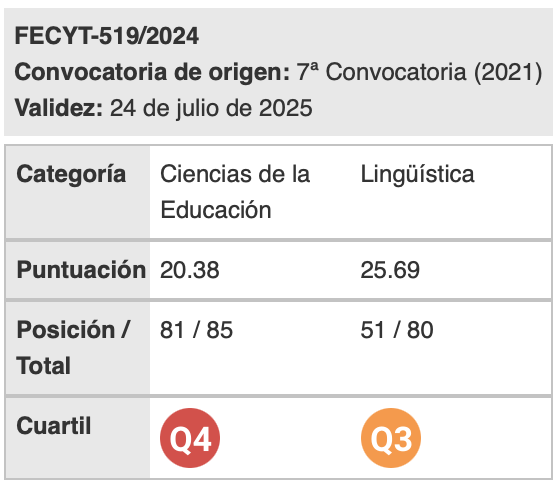CLIL and translation in tertiary education
Palabras clave:
CLIL, translation, tertiary education, L1 interference, lectureResumen
In the past decade, Content Language Integrated Learning (CLIL) has been steadily gaining ground in tertiary-level education, with an increasing number of programmes being implemented. However, and despite this growing trend, there is still a wide scope for research in this area. More specifically, one of the aspects which have hardly received any attention is the role of CLIL lecturers as translators. The aim of this paper is to prove how translation has a say in the quality and performance of lectures in this teaching context. For that purpose, a twofold approach has been followed. On the one hand, eight lecturers’ actual production has been qualitatively analysed following the phasal analysis of lectures as proposed by Young (1994). On the other, the lecturers’ recognition of their role as translators in CLIL lessons has been considered as well. To this double aim, lectures belonging to the fields of Physics and Engineering have been
recorded, transcribed and analysed, with special attention being paid to phasal division. As for our next goal, the answers to a 26-item questionnaire addressed to lecturers and containing reflections on their translating activity have also been thoroughly studied. Findings show that translation does indeed play a pivotal role in the linguistic quality of lectures, with those phases in which translation applies resulting in lower levels of L1 interference. Further research on this area may indeed determine how valuable translation skills are in order to develop a higher efficiency in the preparation and delivery of university lectures.
Descargas
Citas
Aguilar, M. & Rodríguez, R. (2012). Lecturer and student perceptions on CLIL at a Spanish university. The International Journal of Bilingual Education and Bilingualism, 15(2), 183-197.
Alves, F., Vila Real Gonçalves, J. L. & Rothe-Neves, R. (2001). In search of a definition of translation competence: the structure and development of an ongoing research project. Quaderns: Revista de traducció, 6, 46-49.
Beeby Londsdale, A. (1993). Teaching translation from Spanish into English: Worlds beyond words. Ottawa: Ottawa University Press.
Bellés Fortuno, B. & Fortanet, I. (2005). Spoken academic discourse: An approach to research on lectures. Revista Española de Lingüística Aplicada, 1, 161-178.
Braga, J. & Domínguez, L. (2010). Calque-free lectures? Spanish cross-linguistic influence in content teaching through English. ELIA, 10, 113-135.
Carrió, M. L. & Gimeno, A. (2007): Content and language integrated learning in a technical higher education environment. In D. Marsh and D. Wolff (Eds.), Diverse contexts –converging goals: CLIL in Europe (pp. 103-114). Frankfurt: Peter Lang.
Dafouz, E. et al. (2007a). Integrating CLIL at the tertiary level: teachers’ and students’ reactions. In D. Marsh and D. Wolff (Eds.), Diverse Contexts – Converging Goals: CLIL in Europe (pp. 91-101). Frankfurt: Peter Lang.
Dafouz, E., Núñez, B. & Sancho, C. (2007b). Analysing stance in a CLIL university context: Non-native speaker use of personal pronouns and modal verbs. The International Journal of Bilingual Education and Bilingualism, 10(5), 647-662.
Dafouz, E. & Núñez, B. (2009). CLIL in higher education: devising a new learning landscape. In E. Dafouz & M. C. Guerrini (Eds.), CLIL across educational levels (pp. 101-112). Madrid: Richmond Publishing.
Grammenidis, S. & Nenopoulou, T. (2007). The relevance of utter-centered linguistics to Translation Studies. In Y. Gambier et al. (Eds.), Doubts and directions in translation studies (pp. 297-308). Amsterdam & Philadelphia: John Benjamins.
Hurtado Albir, A. (2001). Traducción y traductología: Introducción a la traductología. Madrid: Cátedra.
Lasagabaster, D., & Ruiz de Zarobe, Y. (Eds.) (2010). CLIL in Spain: Implementation, results and teacher training. Newcastle upon Tyne: Cambridge Scholars Publishers.
Martínez Melis, N. & Hurtado Albir, A. (2001). Assessment in translation studies: Research needs. Meta, 46(2), 272-287.
Núñez, B. & Dafouz E. (2007). Lecturing through the foreign language in a CLIL university context: Linguistic and pragmatic implications”. In U. Smit & C. Dalton-Puffer (Eds.), Views: Current research on CLIL 2 (16.3), 36-42.
Odlin, T. (1993). Language transfer: Cross-linguistic influence in language learning. Cambridge: Cambridge University Press.
PACTE. (2000). Acquiring Translation Competence. In A. Beeby (Ed.), Investigating translation (pp. 99-106). Amsterdam & Philadelphia: John Benjamins.
Pym, A. (2003). Redefining translation competence in an electronic age. In defence of a minimalist approach. Meta, 48(4), 481-497.
Rabab’ah, G. A. (2008). Communication strategies in translation. Babel, 54(2), 97-109.
Rabadán, R. (2007). Divisions, description, applications: The interface between DTS, corpus-based research and contrastive analysis”. In Y. Gambier et al. (Eds.), Doubts and Directions in Translation Studies (pp. 237-252). Amsterdam & Philadelphia: John Benjamins.
Ramón García, N. (2002). Contrastive Linguistics and Translation Studies interconnected: The corpus-based approach. Lingüistica Antverpiensia, 1, 393-406.
Young, L. (1994). University lecturers – macro-structure and micro-features. In J. Flowerdew (Ed.), Academic listening: Research perspectives (pp. 159-176). Cambridge: Cambridge University Press.
Zlateva, P. (2002). Translation as a tool in linguistic analysis. Linguistica Antverpiensia, 1, 109-125.
Descargas
Publicado
Cómo citar
Número
Sección
Licencia
Aquellos autores/as que tengan publicaciones con esta revista, aceptan los términos siguientes:
- Los autores/as conservarán sus derechos de autor y garantizarán a la revista el derecho de primera publicación de su obra, el cuál estará simultáneamente sujeto a la Licencia de reconocimiento de Creative Commons que permite a terceros compartir la obra siempre que se indique su autor y su primera publicación esta revista.
- Los autores/as podrán adoptar otros acuerdos de licencia no exclusiva de distribución de la versión de la obra publicada (p. ej.: depositarla en un archivo telemático institucional o publicarla en un volumen monográfico) siempre que se indique la publicación inicial en esta revista.
- Se permite y recomienda a los autores/as difundir su obra a través de Internet (p. ej.: en archivos telemáticos institucionales o en su página web) antes y durante el proceso de envío, lo cual puede producir intercambios interesantes y aumentar las citas de la obra publicada. (Véase El efecto del acceso abierto).

Revista de Lenguas para fines específicos is licensed under a Creative Commons Reconocimiento-NoComercial-SinObraDerivada 4.0 Internacional License.






















